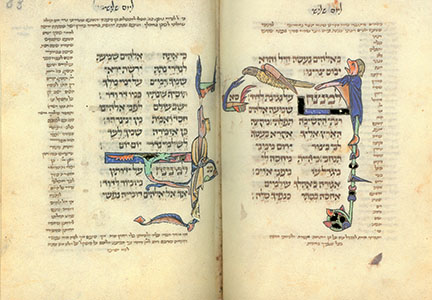
Animals in Jewish, Christian, and Islamic Illustrations from the Middle Ages


The Parma Psalter, Facsimile of the Biblioteca Palatina, MS Parm,
1870 (c. 1280 CE)
1996. London: Facsimile Editions
5.5 in. 4.25 in.
Isser and Rae Price Library of Judaica, Special & Area Studies Collections, George A. Smathers Libraries
The Parma Psalter (Codex de Rossi 510) is one of the earliest and most important Hebrew manuscripts to have survived the upheaval and destruction wrought to the Jews and their books in the Middle Ages. Crafted in Northern Italy around 1280, its tiny but beautifully illustrated pages are extraordinary for a Hebrew manuscript of the period. The original is held in the Palatina Library in Parma, Italy; one of the world’s greatest collections of Hebrew manuscripts.
Unlike the artists of most Christian and Hebrew manuscripts, the illuminator of The Parma Psalter did not follow an ordered plan or a fixed uniform scheme for his ornamentation. Where two Psalms were written across two facing pages, the illuminator treated each Psalm separately and did not try to link the pages together with visual symmetry. By varying his decorative vocabulary and syntax to fit the subject matter of the verses, the artist avoided chromatic monotony, thereby creating something almost modern in its rendering. The artwork is exquisite given the limited space, and much humor characterizes these miniscule drawings. Psalm 61 on folio 82v is illustrated with a hybrid human figure and dog’s head with an open mouth and arms outstretched, and an eagle flying above the text towards the left. Both characters echo the words in the Psalm: “Hear my cry, O Lord…” and “safe under the shelter of thy wings!” Psalm 62 on the opposite page is illuminated by a human and dog hybrid pointing towards a singing bird. This humorous pair probably represent the choirmaster and chorister referred to in the opening lines of the Psalm. The artist was no doubt influenced by the recent appearance of drolleries in contemporary Italian manuscripts.